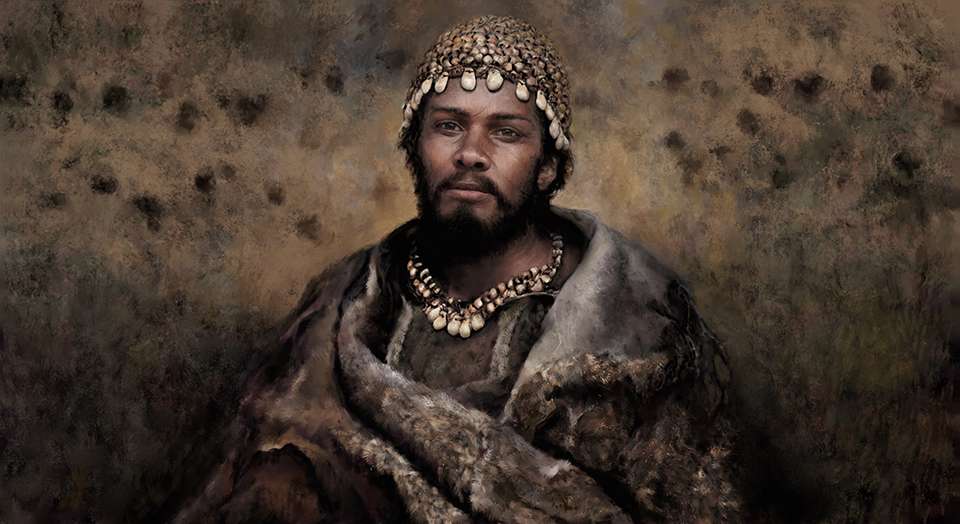CSUN Prof’s Research Helps Uncover Clues About the Lives of European Hunter-Gatherers Who Lived Tens of Thousands of Years Ago

Reconstruction of a hunter-gatherer associated with the Gravettian culture (32,000-24,000 years ago), inspired by the archaeological findings. Image by Tom Bjoerklund
As the climate got colder and colder about 25,000 years ago during the coldest phase of the last Ice Age known as Last Glacial Maximum, the prehistoric hunter-gatherers who populated much of what we now know as Europe fled south.
An international research team that includes California State University, Northridge anthropologist Hélène Rougier have dispelled some preconceptions about the modern humans who are, at least partially, the ancestors of Western Eurasia by analyzing genetic material from bone fragments and piecing together clues from tools and other debris found during archeological excavations.
“There’s long been an assumption, even in the scientific communities, that the early modern humans who lived before the Last Glacial Maximum were genetically connected,” said Rougier, who teaches in the College of Social and Behavioral Sciences. “However, the populations from western and southwestern Eur0pe — the areas we now call France and Iberia — differed genetically from contemporaneous populations from central and southern Europe — today’s Czech Republic and Italy. What makes this even more interesting is that, while they were not genetically connected, it appears that they did share culture. They used similar weapons and produced similar portable art.

California State University, Northridge anthropologist Hélène Rougier examining remains found found in Goyet, a cave in Belgium. Photo courtesy of Hélène Rougier.
“As hunters and gatherers, they were nomadic and traveled around to find food, probably on a seasonal basis,” she said. “But as the climate got colder and food became scarce and the land uninhabitable, they were forced to move to areas where they were more likely to survive; similar to stories we are beginning to hear today from regions of the world facing severe impact from modern climate change.
“As these early Europeans traveled, they crossed paths with other modern humans and spent time together long enough, they socialized long enough, that they were able to share their culture,” Rougier said.
The findings, “Palaeogenomics of Upper Paleolithic to Neolithic European hunter-gatherers,” appeared in the journal Nature.
Rougier is one of 125 researchers from around the world working together for more than a decade to explore prehistoric life in Europe, hoping to gain perspective on what human life was like before recorded history. Their disciplines span the spectrum, from biological anthropology and archaeology to biochemistry and genetics. Rougier said the interdisciplinary approach provides an opportunity to bring new perspectives and raise questions that individuals in a particular specialty may not consider or be able to resolve.
“It’s an invigorating and exciting approach,” she said. “And when we release a study, you can be assured that is has been vetted from all angles.”
By working together, the researchers found that populations from different regions associated with what is called the Gravettian culture, which was widespread across the European continent between 32,000 and 24,000 years ago, were not closely related to each other. Gravettian hunters made spears to kill wooly mammoths and other big game. They also made figurines that might have represented fertility.
The researchers demonstrated that descendants of populations associated with the Gravettian culture stayed in southwestern Europe during the coldest parts of the last Ice Age, and later spread northeastward to the rest of Europe.
The Italian peninsula has long been considered to be another climate refuge for humans during the Last Glacial Maximum. However, the research team found no evidence of this. Hunter-gatherer populations associated with the Gravettian culture and living in central and southern Europe are no longer genetically detectable after the Last Glacial Maximum. People with a new gene pool settled in these areas, instead.
“We believe these people came originally from the Balkans, and then spread south to what we now call Sicily,” Rougier said.
The analyzed genomes also show that the descendants of these inhabitants of the Italian peninsula spread across the rest of Europe about 14,000 years ago, replacing populations associated with the Magdalenian culture, which dates from about 19,000 to 14,000 years ago.
Rougier said the research team believes this large-scale genetic replacement may have been caused, in part, by climatic changes that forced people to migrate.
“This is something to think about as we deal with the impact of our current climate crisis,” she said.
The findings also showed that there had been no genetic exchange between contemporaneous hunter-gatherer populations in western and eastern Europe for more than 6,000 years. Interactions between people from central and eastern Europe can only be detected again from 8,000 years ago.
“There is so much that we are learning as we work together to analyze the data and ask each other questions that we might not have considered if we weren’t working with people from a variety of disciplines,” Rougier said. “When we put all the data from the different fields together, we can really produce studies like this one, which shed new light on assumptions we had taken for granted. While my geneticist colleagues did much of the work on this study, it was very nice to be able to integrate archaeology with their efforts to try to identify who these people were and really try to retrace population histories and migration interactions, and the link with climate change.”

 experience
experience